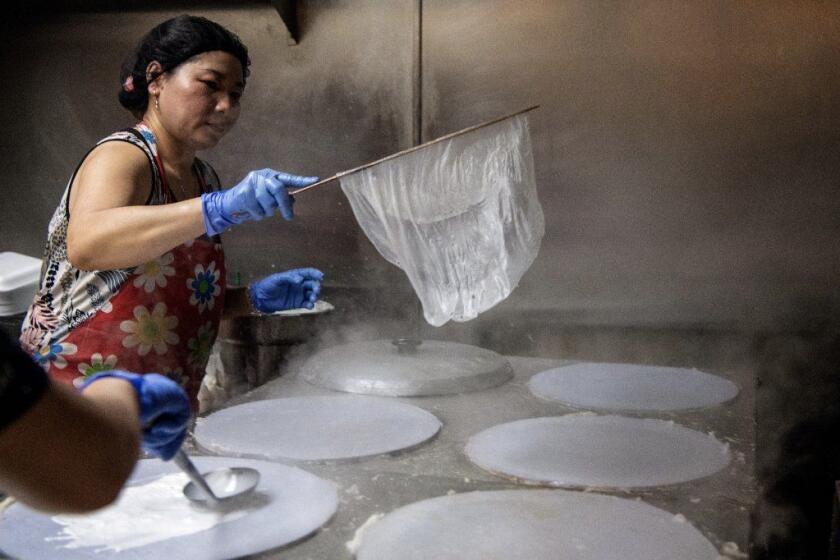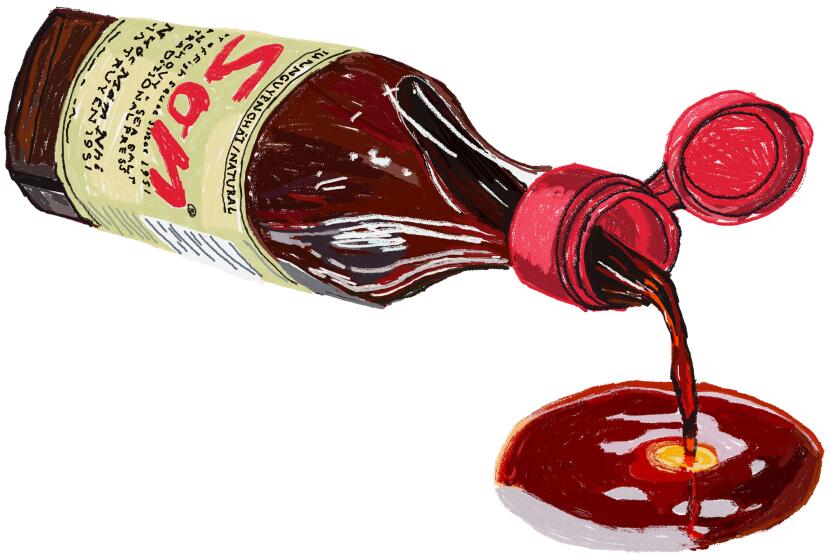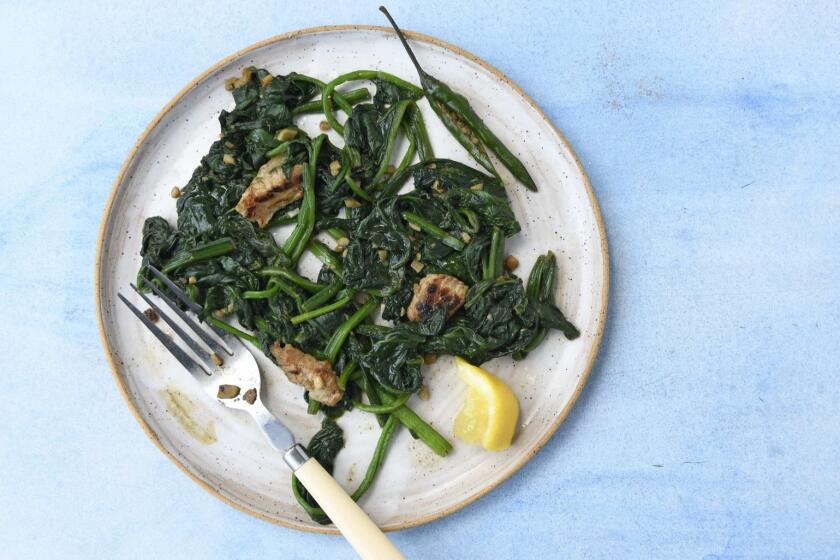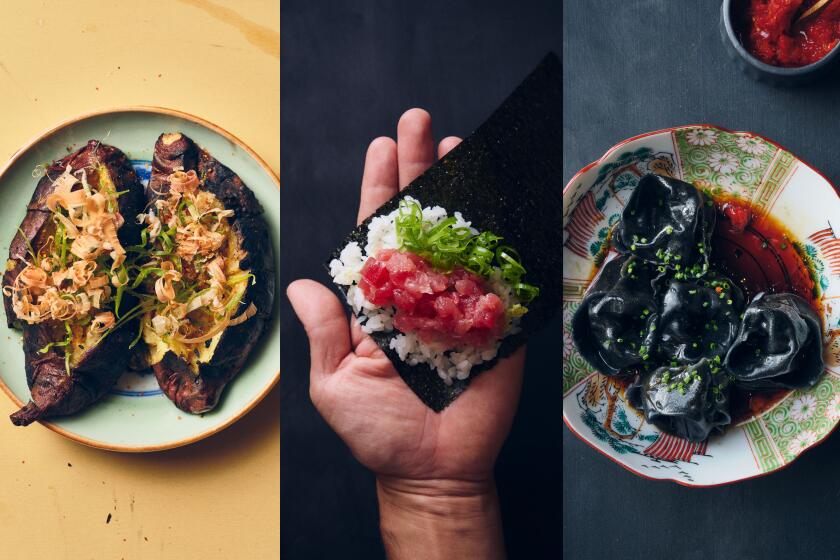Hu tieu lowdown: The Chinese-Vietnamese-Cambodian noodles you need to know better
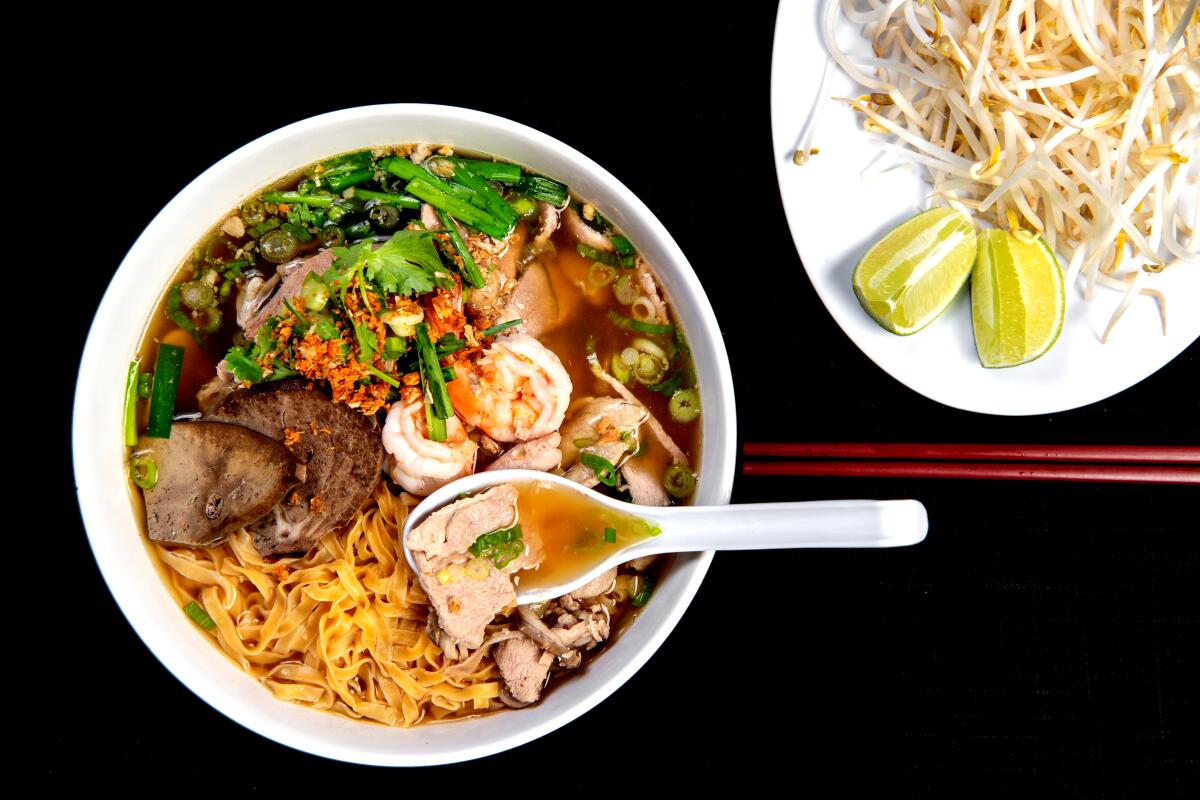
If I need to quickly describe regional Vietnamese food, I boil it down to three noodle soups: Delicate beef pho reflects the traditional purity of Hanoi and its northern environs, gutsy bun bo channels Hue and central Viet determination, and kaleidoscopic hu tieu conveys Saigon’s progressivism and hyper creativity, which flow into the southern provinces too.
Of the three, the least known outside of the Viet community is hu tieu. Its many permutations and combinations have perplexed me (my family has northern and central Viet roots), so I’ve safely stuck to the version I grew up with, hu tieu Nam Vang, a standard. Hoping to slay my ignorance, I recently dove deeper into the southern Viet favorite.
The term itself can confuse. In Vietnamese, hu tieu (say “who teeyoo”) means a flat rice noodle — the same ones you get in a bowl of pho — as well as the southern Vietnamese soup.
Everything you need to know about banh cuon, Vietnamese rice sheets
Both the noodles and soup preparation came to Vietnam with the Teochew, a migratory people from northeastern Guangdong province. When the Teochew settled in Southeast Asia, they meshed their kuay teow with local foodways.
In the Viet repertoire, hu tieu noodle soup expresses itself in a Chinese-Vietnamese-Cambodian style, with broth often marked by umami-laden dried squid and/or shrimp. Whereas most toppings for pho and bun bo Hue are simmered in their broths, hu tieu toppings typically combine surf and turf elements that may be separately boiled, sautéed, roasted and/or fried.
Raw garnishes may include bean sprouts, lettuce, chrysanthemum greens, Chinese celery and garlic chives. Condiment add-ins range from pickled chiles and garlic in mild vinegar to fish sauce, soy sauce, sugar and a savory-spicy chile oil called sot sa-te that’s akin to a mild XO sauce.
When my family escaped the communist takeover of Vietnam and settled in Southern California in 1975, we gained freedom but lost good fish sauce.
There is “wet” hu tieu nuoc, a full-fledged noodle soup flooded with broth, or “dry” hu tieu kho, a noodle salad accompanied by a side of broth. As if that’s not enough variation, you may have hu tieu with tender rice noodles, snappy egg noodles or chewy tapioca noodles. The rice noodle size may be small, medium or large; you may combine rice and egg noodles too. And there’s often an option to add pieces of fried Chinese cruller (dau cha quay).
The dish is a riot of colors, flavors and textures that’s hard to corral. But you can experience different takes at hu tieu hot spots in Orange County and Los Angeles.
For Chinese-Viet versions, head to Trieu Chau Restaurant in Santa Ana. The late morning and midday crowds make for a scene that evokes Southeast Asia. A no-nonsense staff of Asian and Latino men efficiently works the room.
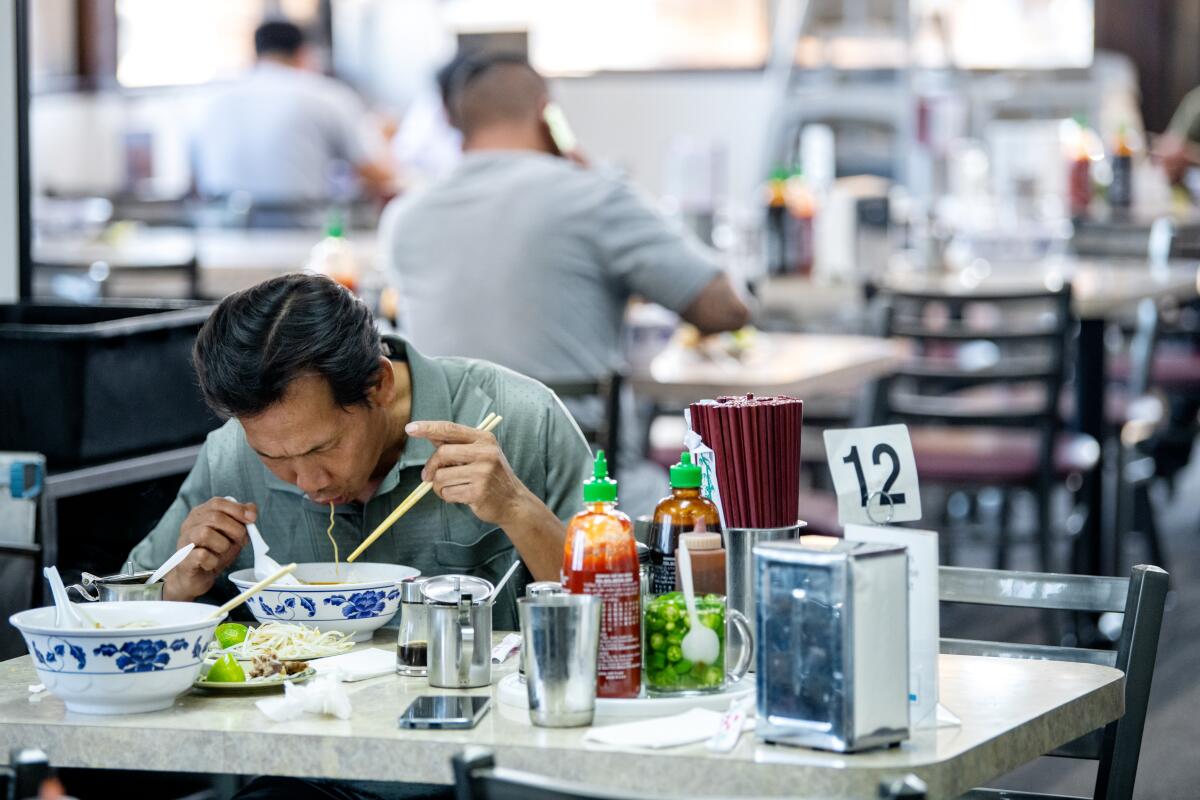
Despite the briskness, don’t be afraid to ask questions. I was a newbie and so was my dining buddy, Diana Zheng, author of “Jia! The Food of Swatow and the Teochew Diaspora.” To decipher the dense trilingual menu, we sought help in Vietnamese, Chinese and English.
The patient waiter suggested hu tieu Trieu Chau dac biet (the special) so we could try all the toppings. Then came the hard part: how to customize our order. “Dry or wet? What kind of noodle? What size noodle? Raw or blanched bean sprouts?” he asked.
Stymied, I asked what he preferred. Try the dry one with small rice noodles and blanched sprouts, he said, and I did. The hu tieu kho was a tour de force featuring about 10 items, including pork, shrimp, kidney and a roasted duck leg.
The soy-based sauce at the bottom of the bowl surprised Zheng, who is used to either no sauce or a little oil or fat enrobing the ingredients at old-school Teochew restaurants like Mien Nghia Noodle Express in Rosemead. There, like in China, she said, the broth was porkier, collagen-rich and less sweet.
Being in Little Saigon, Trieu Chau’s flamboyant rendition mirrored the twists that hu tieu took on as it settled into Viet culture. We mixed everything up and dug in, adding extra condiments to experiment with the flavors and sipping the broth separately; I occasionally poured a spoonful of broth into my bowl to lubricate and season things.
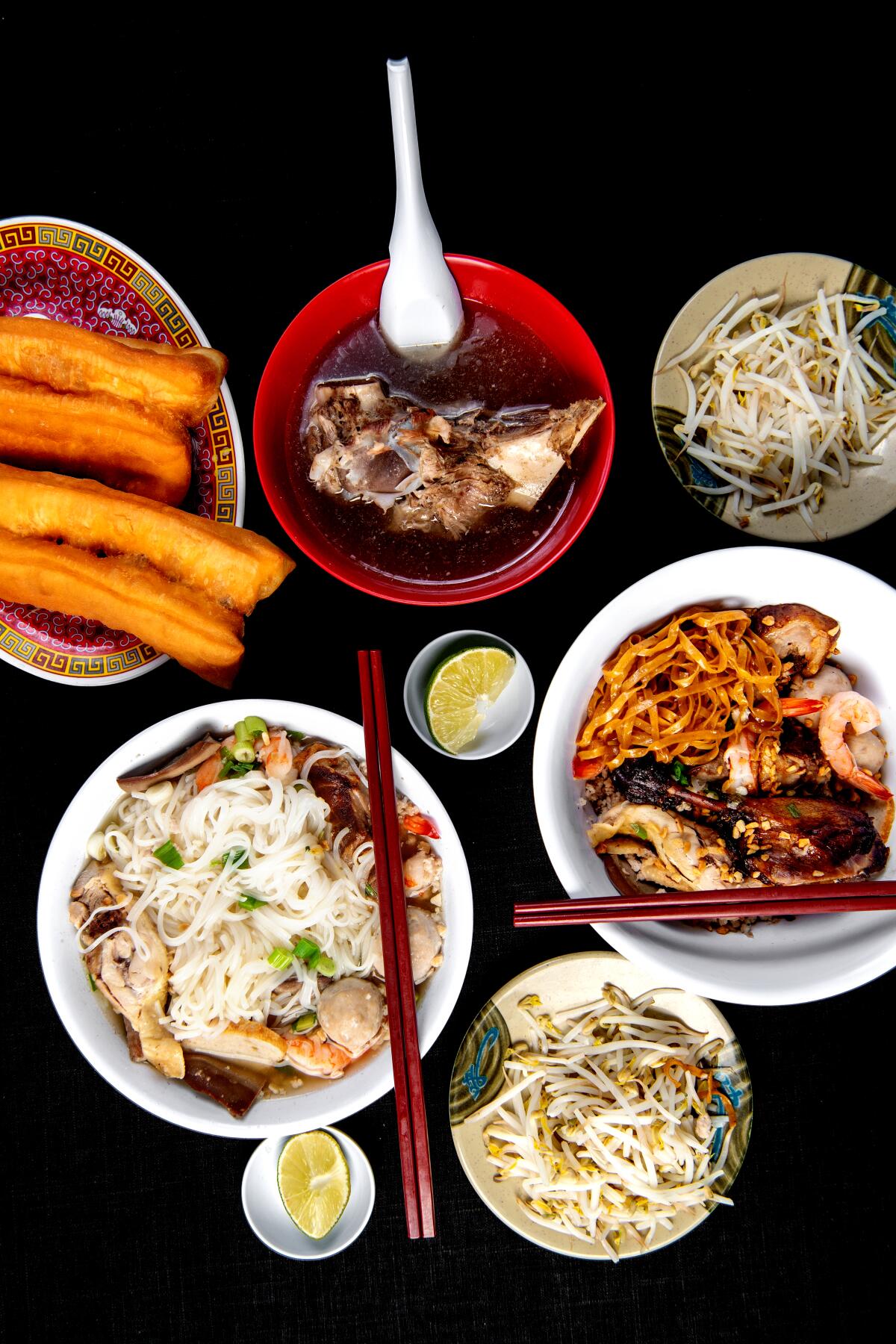
Co Ba Restaurant in Garden Grove offers a smaller menu with Viet-style hu tieu. The broth is sweeter than at Trieu Chau, and the bowls are crafted with attention to detail. Peppery chrysanthemum greens accompany the bean sprout garnish to signal a turn toward the Viet preference for lots of vegetables (though the topping of fried nubbins of pork fat were welcome too.).
Co Ba chef Lap Tran’s culinary heritage combines Vietnamese, Chinese and Cambodian cultures. With a bald pate and friendly confidence that evoked Mr. Clean, he was enthusiastic and insightful.
Fish sauce has crossed over from Vietnamese cuisine to use in all kinds of home and restaurant cooking, but it’s hardly the only fermented sea beast potion that Viet cooks love.
Pared down to the basics, he explained, Teochew-style hu tieu has a broth of pork leg bones and toppings of boiled pork, ground pork and fried garlic. Cantonese versions employ broth fashioned from pork neck bones and chicken bones, and toppings include char siu pork and fried shallots. Phnom Penh-style hu tieu Nam Vang is marked by a sweeter broth. A special kind of extra chewy rice noodle defines hu tieu My Tho, a city in Vietnam’s Mekong Delta.
Despite Tran’s explanation, the foundational differences between different hu tieu have blurred. Even the noodles used for a My Tho version are now made mostly with tapioca, not rice. The noodle soup’s fuzzy evolution makes it hard to understand, I remarked.
“That’s the Chinese way,” he said. “Wherever we go, we pick up some local ideas and add a little something. For example, traditional dry hu tieu did not have any sauce but cooks have developed their own sauces over time. No one knows who started that!”
The sauce for dry hu tieu is a moving target. At Phuong’s Restaurant, the Nam Vang version is seasoned with a soy-based sauce and the My Tho version comes with an unusual tomato-based sauce. After encountering the tomato sauce again at Hu Tieu Thanh Xuan in the heart of Little Saigon, I pinged a friend who’d recently sampled hu tieu in My Tho proper. No tomato sauce where he ate, he said. Maybe it was a Viet-American trend?
Fish sauce smells strong and the workhorse condiment is commonly combined with other ingredients to work its umami magic.
I surprisingly found an answer at the family-owned Phnom Penh Noodle Shack, an institution in Long Beach since 1985. A second generation of the family now runs the place, which is buzzing with lots of customers and Cambodian pop music filling the tiny space.
While trying the dry version of its house special noodles (it came with a side of broth that included Flintstone-size pork bones, which I attacked with fork and fingers), I chatted up Viet customers nearby. The woman and her brother adored their big portions of the Cambodian rendition (kuy teav) and its earthy sweet broth. When she self-identified as a Little Saigon foodie, I inquired about the My Tho tomato sauce.
“Oh, that’s simply the result of a cook moving from one restaurant to another,” she blithely shared.
Such loose adherence to hu tieu tradition and the lust for innovation reminded me of something Tran said at Co Ba: “Vietnamese people are so mixed, with Chinese, French, Indian and American influences. That’s why our food is the best.”
Where and how to find good hu tieu
To get the best hu tieu, you go to a place that specializes in it. Search online for “hu tieu” for Chinese-Viet-Cambodian versions or “kuy teav” for a Cambodian rendition. Ideally, the menu will list noodle soups first and foremost. Trieu Chau (a.k.a. Teochew, Chaozhou, Chiu Chow) spots may offer hu tieu too. I’ve yet to have a good version at a pho shop; the two broths are different so it’s hard to make both well.
Traditional hu tieu restaurants open early for breakfast and close early, rarely serving dinner. There are only a few of them so they tend to be extra busy on weekends. Among the spots to put on your radar:
Los Angeles County
Golden Lake Eatery, 424 W. College St., Los Angeles
Kim Chuy, 727 N. Broadway #103, Los Angeles
Kim Kee Noodle Cafe, 441 W. Garvey Ave., Monterey Park
Kim Ky Noodle House, 1108 S. San Gabriel Blvd., San Gabriel and 15041 Moran St., #107, Westminster
Mien Nghia Noodle Express, 7755 E. Garvey Ave., Rosemead
Phnom Penh Noodle Shack, 1644 Cherry Ave., Long Beach
Orange County
Co Ba, 10642 Westminster Ave., Garden Grove
Hu Tieu Thanh Xuan, 9191 Bolsa Ave., Ste. 104-105, Westminster
Phuong’s Restaurant, 10722 Westminster Ave., Garden Grove
Trieu Chau Restaurant, 4401 W. 1st St., Santa Ana
How to order hu tieu
Take a choose-your-own-adventure approach when ordering hu tieu. For the Full Monty, order the dac biet or thap cam options; If you don’t like offal, pick out the kidney or liver and keep eating. Wet hu tieu is soothing and synergistic whereas dry hu tieu allows you to separately taste the broth and bowl components in a more pure and intense manner. Try different kinds of noodles (menus may have descriptions). Mix noodle types if you’re on the fence. Condiments vary at the restaurants. Experiment with what’s on the table. It’s the hu tieu way.
More to Read
Eat your way across L.A.
Get our weekly Tasting Notes newsletter for reviews, news and more.
You may occasionally receive promotional content from the Los Angeles Times.
